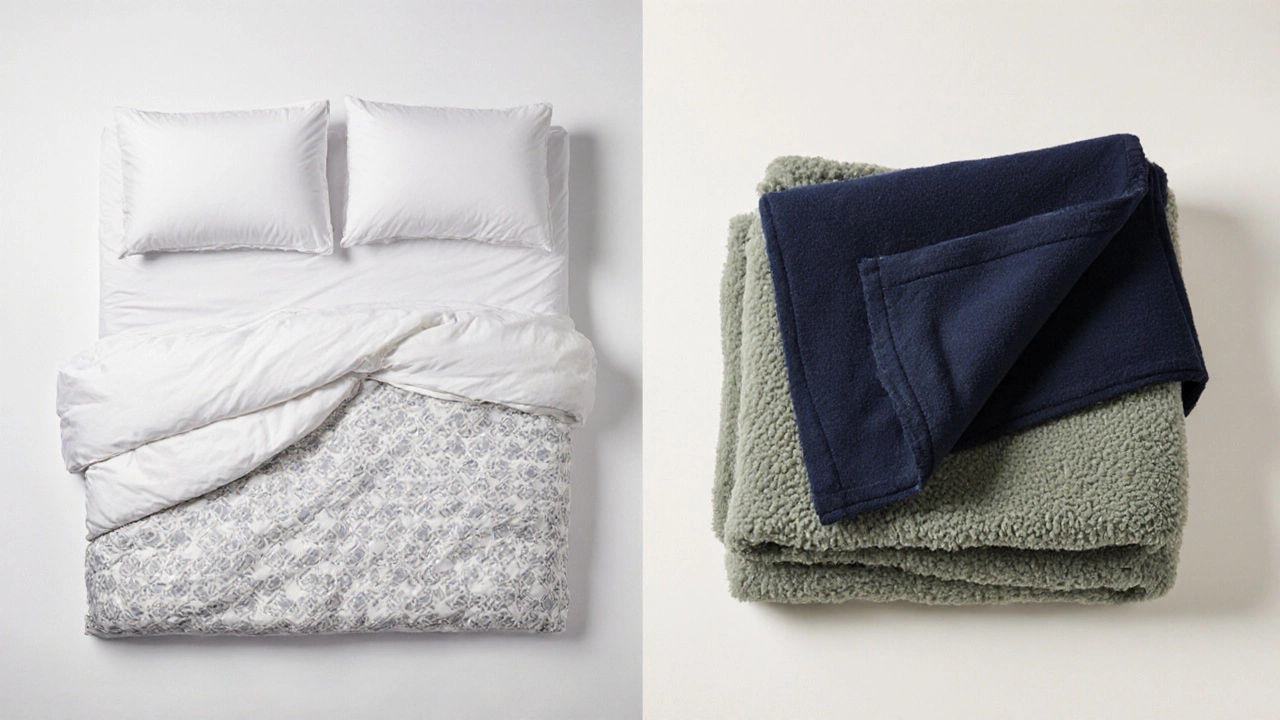Bedding vs Blankets: Quick Comparison Tool
Bedding refers to the complete set of linens and accessories used to make a bed, including sheets, pillowcases, duvets, and covers. A blanket is a single warm layer that can be added on top.
- Fitted Sheet
- Flat Sheet
- Pillowcases
- Duvet or Comforter
- Duvet Cover
- Bedspread or Throw
- Single Layer
- Warmth Focused
- Portable
- Decorative or Functional
- Standalone Piece
| Aspect | Bedding | Blanket |
|---|---|---|
| Definition | A coordinated set of sheets, pillowcases, and top layers. | A single layer meant for warmth. |
| Materials | Cotton, linen, microfiber, satin. | Wool, fleece, cotton, acrylic. |
| Purpose | Comfort, hygiene, décor. | Heat retention. |
| Placement | Under and over the mattress, covering pillows. | On top of the bed or used elsewhere. |
| Maintenance | Often machine-washable, multiple pieces. | Usually washable, but may require special care for wool. |
Use bedding when you want a complete, hygienic, and stylish setup for your bed. Use blankets for extra warmth or portability.
Ever stood in the bedroom aisle and wondered whether the word “bedding” is just a fancy way of saying “blankets”? You’re not alone. The two terms often get tossed around as if they mean the same thing, but they actually cover different ground. Below we break it down, list everything that belongs in a proper bedding set, compare the key pieces, and give you practical tips for picking the right stuff for your sleep space.
What Exactly Is Bedding is the collection of fabrics and accessories that dress a bed, from the fitted sheet that hugs the mattress to the decorative accents on top.
Think of bedding as a outfit for your bed. It includes the fitted sheet, flat sheet, pillowcases, duvet cover (or comforter), and any decorative layers like a bedspread or throw. The purpose is two‑fold: comfort while you sleep and visual harmony with the rest of the room.
How Does a Blanket differ?
A blanket is a single layer of fabric-usually woven, knitted, or quilted-designed primarily for warmth. It sits on top of the other bed layers and can be used on a couch, outdoors, or as a cozy wrap. Blankets are not a set; they’re a standalone piece.
Quick Side‑by‑Side Comparison
| Aspect | Bedding | Blanket |
|---|---|---|
| Definition | A coordinated set of sheets, pillowcases, and top layers. | A single layer meant for warmth. |
| Typical Materials | Cotton, linen, microfiber, satin. | Wool, fleece, cotton, acrylic. |
| Primary Purpose | Comfort, hygiene, décor. | Heat retention. |
| Placement | Under and over the mattress, covering pillows. | On top of the bed or used elsewhere. |
| Maintenance | Often machine‑washable, multiple pieces. | Usually wash‑able, but may require special care for wool. |
The Core Pieces of a Complete Bedding Set
- Fitted Sheet - Holds the mattress snugly; elastic corners keep it from slipping.
- Flat Sheet - Offers a smooth surface between you and the top layer; optional in many modern setups.
- Pillowcase - Covers pillows; can match or contrast the sheets.
- Duvet or Comforter - The main warm layer, usually inserted into a duvet cover.
- Duvet Cover - Protects the duvet and adds style.
- Bedspread or Throw - Decorative layer for visual impact.
- Mattress Protector - Shields the mattress from spills and dust mites.
When you combine all these pieces, you’ve got a full bedding set. Blankets, on the contrary, would be an extra top layer you might add for extra warmth during a cold night.

Choosing the Right bedding for Your Bedroom
Here’s a quick cheat‑sheet you can follow:
- Know your bed size. A twin, full, queen, or king determines the dimensions of every piece. Buying a queen‑size fitted sheet for a double bed leads to constant sliding.
- Pick a material that fits your lifestyle. Cotton is breathable and easy to wash; linen feels luxurious but wrinkles more; microfiber is cheap and soft but can trap heat.
- Count the layers you need. Warm climates may only need a sheet set and a light blanket. Chillier regions benefit from a duvet plus a heavier blanket or a separate quilt.
- Match the thread count to comfort. For cotton, 200‑400 is a good range. Higher counts feel smoother but cost more.
- Consider care instructions. Some duvet covers are machine‑washable; others require dry cleaning. Align the upkeep with your schedule.
Common Misconceptions About Bedding and Blankets
Myths pop up often:
- My blanket can replace a duvet. A blanket may keep you warm, but it won’t protect a duvet from dust or spills.
- All sheets are the same. Fabric weight, weave (percale vs sateen), and finish dramatically affect feel and durability.
- Blankets are just decorative. While decorative throws add style, a quality blanket provides essential insulation, especially in older homes.
Understanding these nuances helps you avoid buying items you’ll never really need.
Care Tips to Keep Your Bedding Fresh
- Wash sheets every 1‑2 weeks; the higher the thread count, the gentler the cycle.
- Rotate your duvet and blankets every few months to even out wear.
- Use a mattress protector; it adds a barrier against spills and can be wiped down.
- Store seasonal blankets in breathable bags, not plastic, to prevent mildew.
When to Use a Blanket Instead of Adding More Bedding
If you only need occasional extra warmth-like a chilly summer evening-pulling a lightweight blanket from a closet is quicker than swapping out a heavy duvet. Blankets are also portable, so you can take them to the couch or even on a weekend trip.
Frequently Asked Questions
Is a blanket part of bedding?
A blanket can be used as a top layer, but it isn’t considered part of a complete bedding set, which includes sheets, pillowcases, and a duvet or comforter.
Can I use a duvet cover without a duvet?
A duvet cover alone won’t provide warmth; it’s designed to protect and style a duvet. Without the inner filling, you’ll need another warm layer, such as a blanket.
What’s the difference between a comforter and a duvet?
A comforter is a stitched, insulated blanket that’s ready to use. A duvet is a plain, often unstitched insert that requires a cover.
How often should I wash my duvet cover?
Most experts recommend washing a duvet cover every 2‑3 weeks, or more often if you have allergies. Follow the manufacturer’s care label for temperature settings.
Are blankets better than throws for winter?
Throws are usually lighter and decorative, while blankets-especially wool or heavy fleece-offer more insulation. For cold nights, stick with a proper blanket or a heavy duvet.

